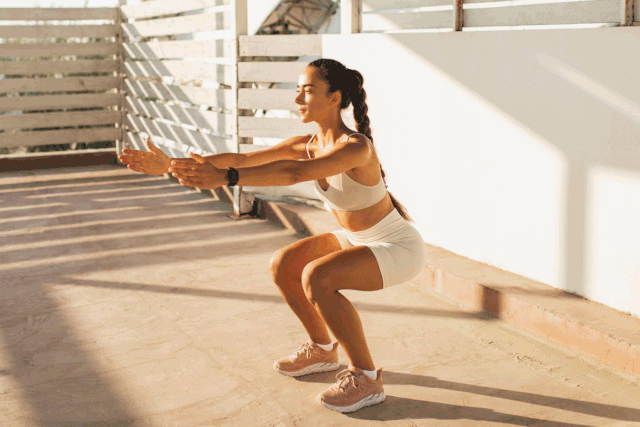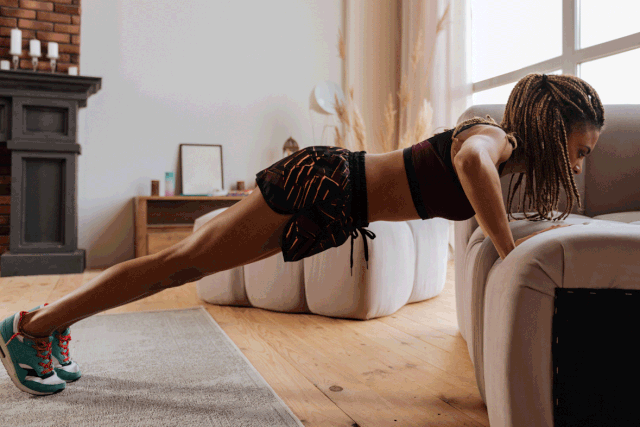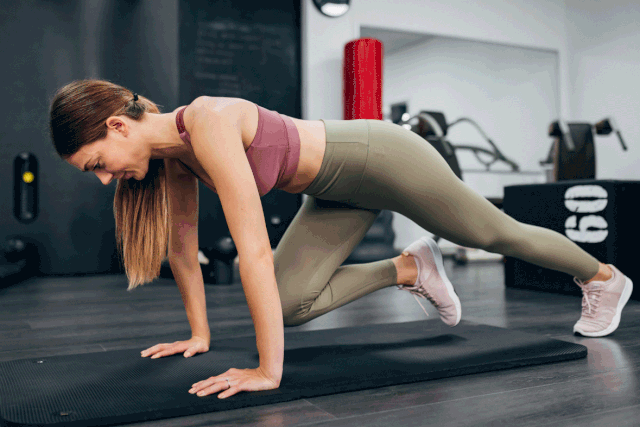This Tabata Workout Takes HIIT to Another Level in Under 5 Minutes
Everything to know about Tabata and its healthy exercise benefits.

Inside Creative House / Getty Images
Whether you have 10 minutes at your disposal or a full hour to exercise, doing a high-intensity interval training (HIIT) workout is one of the most efficient, high-energy ways to get you sweaty and your heart rate up in a minimal amount of time. It’s a fitness format that involves alternating between intervals of hard, high-intensity movement and periods of rest or easy work. One popular HIIT format is Tabata, an even more challenging, but super-rewarding workout that you can find being implemented anywhere from in-person spin classes to at-home exercise programs.
What exactly is a Tabata workout,and how is it different from a traditional HIIT workout? Here’s a full breakdown of the definition of Tabata, its healthy benefits, and a sample Tabata routine developed by a certified fitness trainer that you can do at home.
Related: Move Over, HIIT—EMOM Workouts Are About to Be Your New Aerobic Obsession
What Is a Tabata Workout?
“Tabata is a form of high-intensity interval training developed by Japanese scientist Izumi Tabata[, [PhD,]” explains certified personal trainer Andrew White of Garage Gym Pro, who often uses Tabata training with his clients. “This workout structure is known for its efficiency and effectiveness in combining cardiovascular and strength training.”
Tabata training breaks a workout down into clearly defined time intervals, with a ratio of two to one, hard work to rest. It typically involves 20 seconds of intense, all-out-effort exercise followed by 10 seconds of rest—this pattern gets repeated eight times for a total of four minutes per set.
You can pack in a lot of movement, effort, and energy into just four minutes with Tabata, and since it’s a time-based format you can use it for almost any type of exercise, whether you’re running and walking outside, cycling on a stationary bike, on a mat at home with circuit exercises (like squats, jumping jacks, and lunges), or doing a core-strength series.
“While you can use this method with almost any exercise, I recommend balancing traditional strength-training exercises with plyometric movements,” says online and virtual certified personal trainer Julie Lohre. “Since this kind of training is so intense, I recommend completing four minutes of Tabata at a time, followed by an extended recovery before doing a second Tabata breakout.”
Related: How to Do the 12-3-30 Walking Treadmill Workout for a Seriously Good Sweat
Why Tabata Is So Good for You
Tabata comes with a number of impressive health benefits that go beyond simply helping you stay active. For starters, it’s a great workout regimen for busy individuals who may not have a ton of time to hit the gym or take a long walk or jog—while offering just as many positive health impacts as longer workouts.
“[With Tabata] you spike your heart rate and light a fire in your metabolism, while still activating your muscles,” Lohre explains, who particularly loves Tabata workouts for their efficiency.
Studies show that doing Tabata-style HIIT workouts can boost heart and lung health and increase overall aerobic power, or how hard you can exert yourself. White adds that because many Tabata exercises (like squatting or holding a plank) don’t require equipment, they can help build muscle strength from pretty much anywhere. “Many Tabata exercises use body weight, contributing to muscle development and toning,” he says.
Can Anyone Do Tabata Workouts?
While anyone can give Tabata a try—and modify the types of exercises done to suit their fitness level and needs—both White and Lohre agree it’s not always the best fit for everyone. It requires some practice and getting used to if you're going to do it often.
“Beginners, those with certain health conditions, or older adults might find this format too challenging,” White says of Tabata’s intensity and rigor. “It's important to build up a fitness base or consult a healthcare professional before jumping into Tabata workouts.”
“If you have health conditions preventing you from spiking your heart rate or joint issues, you should get your doctor's OK before doing Tabata training,” Lohre echoes. “The high-impact nature of Tabata can be too much if you have knee, back, or hip joint problems.”
How to Do Tabata Safely
There are steps you can take to do Tabata safely and avoid injury. You can always modify certain moves to be a lower (or no-) impact exercises to accommodate individual concerns.White suggests doing a warm-up before diving into Tabata to help prepare your muscles and joints, as well as staying hydrated both before and during the workout. “If any exercise feels too strenuous, or if you experience discomfort, it's important to pause and rest,” he says. “Maintaining the correct form is also vital to avoid injuries, especially when fatigued.”
Sample At-Home Tabata Workout
You don’t have to sign up for a pricey exercise program or buy new equipment to give Tabata a try. All you need is a bit of space around you to move, workout clothes and sneakers, an exercise mat, and at least four minutes to get in a solid Tabata-based sweat session.
Here, White shares a quick Tabata routine to maximize your workout and reap the most health benefits.
Perform exercise one for 20 seconds, followed by 10 seconds of rest; perform exercise two for 20 seconds, followed by 10 seconds of rest; and so on until you’ve completed all four exercises. Repeat this series in this format eight times through (or for as long as desired—start where you are and build your way to doing it eight times through!).
“Remember to listen to your body and modify as needed,” White explains. “Tabata workouts are an excellent way to improve fitness in a short time. However, it's important to prioritize safety and start at an intensity that suits your fitness level.”
Exercise #1: Bodyweight Squats

Getty Images
Stand with feet shoulder-width apart.
Squat down, bending at the knees and hips, keeping your back straight.
Stand back up and repeat.
To modify, squat to sit onto a chair for support and stand back up.
Exercise #2: Push-Ups

Getty Images
Start in a high plank position.
Lower your body to the ground, then push back up.
To modify, perform knee push-ups or use a higher surface (like the back of a couch, a bench, a sturdy countertop, etc).
Related: 7 Underrated Benefits of Push-Ups, According to Fitness Trainers
Exercise #3: Jumping Jacks

Getty Images
In a standing position with arms at your sides, jump your feet out wide and swing your hands up overhead as if to touch.
Jump back to the starting position.
To modify, use the same arm motion, but alternate stepping out your right leg then your left leg instead of jumping your feet wide.
Exercise #4: Mountain Climbers

Getty Images
Start in a high plank position.
Draw one knee at a time up to your chest then back to starting, alternating knees rapidly in a running-like motion.
To modify, slow down the movement, stepping each foot forward and replacing it before stepping the opposite knee forward.
Related: This 10-Minute Plank Workout Will Fire Up Your Core With Just 5 Moves
For more Real Simple news, make sure to sign up for our newsletter!
Read the original article on Real Simple.

 Yahoo Sport
Yahoo Sport 





































